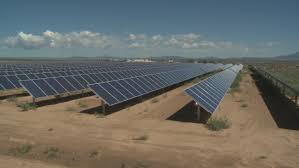Solar energy became the top new energy source in the U.S. for 2016 with new installations doubling last year. Since January of this year, Oklahoma has welcomed two new solar farms aimed at providing a green and renewable source of energy for the Sooner State.
In late October, construction began near Marietta on two acres of property east of State Highway 32, where Red River Valley Rural Electric Association has erected 950 solar panels. Red River Valley serves 15,000 rural customers in southern Oklahoma across Love, Carter, Marshall, Jefferson and Johnston counties. The panels can generate enough electricity to power 35 homes.
“The cost for the output for the solar project will be at a fixed rate, versus using fossil fuels where we have fuel costs fluctuating,” said Kordale Lornes, Assistant Director of Marketing for RRVREA. “Not only is it important for us to try and keep costs down for our members, but we feel this is the right move. We want to help preserve our planet.”
Anadarko-based Western Farmers Electric Cooperative has erected an even larger solar farm on a 44-acre property located west of State Highway 19 near Cyril in southwestern Oklahoma, where the site is filled with rows of 20,000 solar panels facing the sun.
“We want to understand the long-term life cycle cost of solar energy,” said Brian Hobbs, vice president of legal and corporate services for WFEC. “We built this so that we can start to understand how solar and wind energy can support each other.”
Construction on the massive Cyril solar farm began in 2016. The panels can generate five megawatts, enough electricity to power 400 homes. The Cyril site is one of five in comparable size and scale. The others are located in Tuttle, Hinton, Marietta and south of Fort Cobb in Pine Ridge.
“We wanted to concentrate in the southwestern part of the state, south of Interstate 40 and west of Interstate 35,” said Hobbs. “We needed sites that were close to substations so that we can feed the electricity onto the grid and where it can handle the load. And, as you can see, it takes quite a bit of land. We wanted something generally flat and open, so that led us here.”
WFEC continues to study various energy sources. In 2003, WFEC became the first electric provider and co-op to sign a power purchase agreement with a wind farm developer. Nearly 15 years later, the investment in wind energy has paid dividends of the technology continues to progress and produce steadier costs. It seems solar energy is following a similar path.






